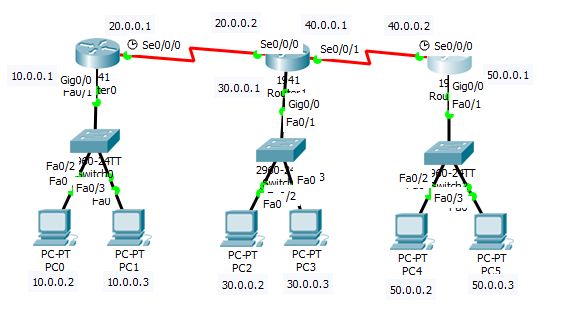Configuration of Static Routing | In
this article we learn about the concept of the static routing, what are the advantage and what are the
disadvantage of the static routing and how to configure static routing .
Function of Router
Normally Router is the network device which use to
establish a communication between two different networks. Router establishes
communication between two networks though
is routing table.
Different types of Routing Methods
Three type of Routing method are available to route
a packet from one network to other network.
- Static Routing
- Default Routing
- Dynamic Routing
Concept of Static Routing
It is one type of Routing Method. Routing table is
not updated automatically in this routing method. We should configure static routing
manually and selection the route which is basically configured by network
admin.
Advantage of Static Routing
There are several advantages of static Routing.
- Static Routing reduces the overhead of cpu of router as routing table is not updated automatically.
- As static routing is basically configured by network admin manually so it is under control of network administrator.
Disadvantage of Static Routing
There are several disadvantages of static Routing.
- Static routing is not suitable for large network.
- Any updation of routing table must be done by network admin manually.
Lab Diagram
 |
| Static Routing lab using packet tracer |
In the above diagram we configure the static routing
for three router.
Configuration of Static Routing
First we configure on router0.
Router#conf
t
Enter
configuration commands, one per line. End with CNTL/Z.
Router(config)#int
gigabitEthernet 0/0
Router(config-if)#ip
address 10.0.0.1 255.0.0.0
Router(config-if)#no shut
Router(config)#int
serial 0/0/0
Router(config-if)#clock
rate 64000
Router(config-if)#ip
address 20.0.0.1 255.0.0.0
Router(config-if)#no shut
To configure static route on router0 we should
execute the below command.
Router(config)#ip
route 30.0.0.0 255.0.0.0 20.0.0.2
Router(config)#ip
route 40.0.0.0 255.0.0.0 20.0.0.2
Router(config)#ip route 50.0.0.0
255.0.0.0 20.0.0.2
Then we configure on router1.
Router#conf
t
Enter
configuration commands, one per line. End with CNTL/Z.
Router(config)#int
gigabitEthernet 0/0
Router(config-if)#ip
address 30.0.0.1 255.0.0.0
Router(config-if)#no
shu
Router(config)#int
serial 0/0/0
Router(config-if)#ip
address 20.0.0.2 255.0.0.0
Router(config-if)#no
shut
Router(config)#int
serial 0/0/1
Router(config-if)#ip
address 40.0.0.1 255.0.0.0
Router(config-if)#no
shut
To configure static route on router1 we should
execute the below command.
Router(config)#ip
route 10.0.0.0 255.0.0.0 20.0.0.1
Router(config)#ip
route 50.0.0.0 255.0.0.0 40.0.0.2
Then we configure on router2.
Router#conf
t
Enter
configuration commands, one per line. End with CNTL/Z.
Router(config)#int
gigabitEthernet 0/0
Router(config-if)#ip
address 50.0.0.1 255.0.0.0
Router(config-if)#no
shut
Router(config)#int
serial 0/0/0
Router(config-if)#clock
rate 64000
Router(config-if)#ip
address 40.0.0.2 255.0.0.0
Router(config-if)#no
shut
To configure static route on router2 we should
execute the below command.
Router(config)#ip
route 30.0.0.0 255.0.0.0 40.0.0.1
Router(config)#ip
route 20.0.0.0 255.0.0.0 40.0.0.1
Router(config)#ip route 10.0.0.0
255.0.0.0 40.0.0.1
Verify of Static Routing
Before configuration of static routing when we
communicate fom pc4 to pc0 we get the below output.
Packet
Tracer PC Command Line 1.0
C:\>ping
10.0.0.2
Pinging
10.0.0.2 with 32 bytes of data:
Reply
from 50.0.0.1: Destination host unreachable.
Reply
from 50.0.0.1: Destination host unreachable.
Reply
from 50.0.0.1: Destination host unreachable.
Reply
from 50.0.0.1: Destination host unreachable.
Ping
statistics for 10.0.0.2:
Packets:
Sent = 4, Received = 0, Lost = 4 (100% loss)
After configuration of static routing when we
communicate fom pc4 to pc0 we get the below output.
C:\>ping 10.0.0.2
Pinging 10.0.0.2 with 32 bytes of data:
Request timed out.
Reply from 10.0.0.2: bytes=32 time=31ms
TTL=125
Reply from 10.0.0.2: bytes=32 time=25ms
TTL=125
Reply from 10.0.0.2: bytes=32 time=31ms
TTL=125
Ping statistics for 10.0.0.2:
Packets: Sent = 4, Received = 3, Lost =
1 (25% loss),
Approximate round trip times in
milli-seconds:
Minimum = 25ms, Maximum = 31ms, Average
= 29ms
If this article is helpful to know about Concept,Advantage,Configuration of Static Routing please share this.

0 comments:
Post a Comment